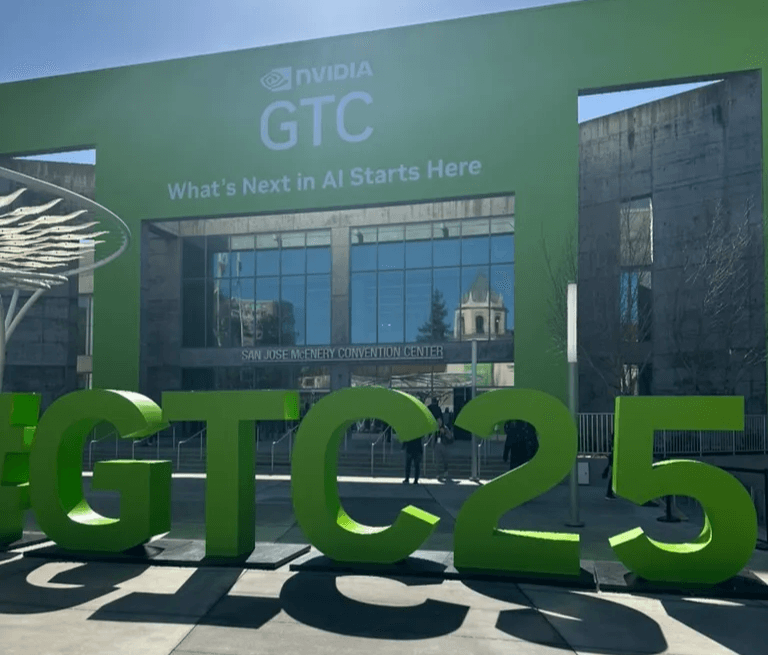Community
30 March 2025
GTC 2025 Recap: Why No One Has Won the MLOps Market — Yet
Let’s explore the evolving dynamics shaping the MLOps (Machine Learning Operations) landscape as of late March 2025 — particularly through the lens of firsthand conversations and observations from NVIDIA’s GTC 2025, one of the most influential gatherings in the AI infrastructure world.

MLOps — the fusion of ML, DevOps, and Data Engineering — has rapidly become critical infrastructure. As AI shifts from experimentation to production, MLOps enables teams to scale, monitor, and operationalize their models effectively. And as witnessed at GTC this year, the urgency to "Agentic AI — productionize AI" is stronger than ever, with MLOps platforms emerging as the backbone of this transition.
No Clear Winner — And Retention Remains a Core Challenge
One of the clearest takeaways from GTC 2025 is that the MLOps market remains wide open. Despite dozens of vendors marketing themselves as “end-to-end” solutions, no single platform has emerged as the dominant player. Teams continue to face fragmented tooling, integration pain, and trade-offs between flexibility and lock-in — and nearly every vendor's messaging sounds strikingly similar.
What’s more, even platforms that have achieved strong initial traction struggle with customer retention. Conversations throughout GTC revealed that churn is widespread, even among teams that had once fully committed to specific solutions. This signals that many buyers are still in evaluation mode, constantly reassessing their stack as needs evolve. In this environment, long-term success depends not only on feature depth, but also on go-to-market execution — specifically:
- Distribution: Winning initial adoption through community, integrations, or virality
- Retention: Keeping users by delivering reliability, performance, and seamless developer experience
- Features: Providing differentiated, real-world capabilities that solve core pain points
The implication is clear: no one has “won” MLOps yet, and in a market still shaping itself, platforms must prioritize usability, modularity, and GTM precision just as much as technical sophistication.
Movements from the Giants
Large infrastructure and software companies are racing to build or buy their way into MLOps, aiming for tighter vertical integration. This was one of the dominant themes at GTC, with numerous vendors announcing acquisitions or showcasing early versions of their integrated stacks.
Recent MLOps expansion movements by AI Infrastructure Giants:

A common issue across these efforts: lock-in. Acquired platforms often get tightly coupled with specific hardware or cloud stacks, reducing flexibility and interoperability for users working across diverse infrastructures — a problem frequently brought up by system integrators and enterprise leads during side discussions at the conference.
Specialized Features Shape Customer Fit
Each MLOps product tends to focus on different functional strengths — which in turn shape who their ideal users are.
For example, features like air-gapped deployment appealed to conference attendees from the public sector and healthcare industries, while others focused on real-time observability or pipeline automation drew crowds from high-frequency trading and robotics.
This specialization means there’s no universal MLOps buyer. The feature set defines the audience.
Momentum Meets Growing Pains
The MLOps market is accelerating rapidly, fueled by the broader adoption of AI across industries and the need to operationalize models efficiently. As organizations push AI from prototype to production, MLOps enables faster deployment, better performance, and stronger governance. The field is maturing — ad-hoc practices are giving way to standardized workflows and increasingly integrated tooling.
GTC served as a showcase for this maturity. Sessions on feature stores, observability, and LLMOps pipelines were packed — a clear sign of growing demand for depth and specialization. While cloud providers dominate with scalable, bundled platforms, many teams still favor best-of-breed solutions that offer flexibility and modularity. Open source tools continue to underpin much of the ecosystem, while innovation flourishes in areas like compliance automation, model monitoring, and edge deployment.
Despite this momentum, challenges persist. Tooling fragmentation, talent shortages, and integration complexity remain barriers to scale. Many organizations still struggle to align teams across data science and engineering, while the cost of infrastructure — especially for large-scale training and inference — continues to be a major constraint. Yet, the opportunity remains massive. With projected CAGRs of 30–40% and market valuations expected to reach tens of billions by decade’s end, MLOps is poised for explosive growth. Platforms that can stay open, interoperable, and developer-first will be best positioned to lead this next wave.
Final Thoughts
MLOps in 2025 remains a fast-moving, high-potential battleground. While infrastructure giants pursue vertical control, and startups build best-in-class features, no one has won — yet.
The winners will be those who master GTM execution, remove friction for users, and remain adaptable to the diverse realities of AI deployment.
After a week immersed in GTC’s booths, talks, and hallway conversations, it’s clear: MLOps remains as core infrastructure. The next generation of platforms must not only solve technical complexity — they must do it in a way that feels effortless, modular, and scalable.
At VESSL AI, we believe the future of MLOps is open, composable, and GPU-native — and we’re building exactly that.
About VESSL AI
VESSL AI is building toward that future. As a modular MLOps and GPU orchestration platform, VESSL AI empowers ML teams to run, scale, and manage experiments and models with ease — whether on the cloud, on-prem, or across hybrid GPU clusters. Unlike vertically locked solutions, VESSL AI is designed to be infrastructure-agnostic, developer-first, and interoperable by default, integrating seamlessly with the open-source ecosystem while offering the enterprise-grade capabilities needed for production AI.

Simon
Business Development Manager
Try VESSL today
Build, train, and deploy models faster at scale with fully managed infrastructure, tools, and workflows.